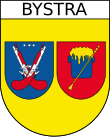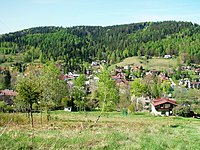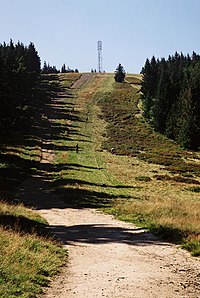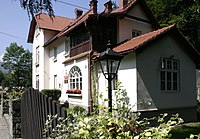Bystra (Wilkowice)
| Bystra | ||
|---|---|---|

|
|
|
| Basic data | ||
| State : | Poland | |
| Voivodeship : | Silesia | |
| Powiat : | Bielsko-Biała | |
| Gmina : | Wilkowice | |
| Area : | 13.79 km² | |
| Geographic location : | 49 ° 46 ' N , 19 ° 4' E | |
| Residents : | 3500 (2006) | |
| Postal code : | 43-360 | |
| Telephone code : | (+48) 33 | |
| License plate : | SBI | |
| Economy and Transport | ||
| Next international airport : | Katowice | |

Bystra ( German Bistray or Bistrai ) is a village in Gmina Wilkowice in Powiat Bielski in the Silesian Voivodeship in southern Poland .
geography
Bystra lies in a valley in a northern foothills of the Silesian Beskids (Beskid śląski) .
The city center of Bielsko-Biała is about 6 km north.
The village has an area of 1379 ha .
The entire place is traversed by the river Bialka - which in its further course is called Biała. The Bialka divides the place into Bystra Śląska ("Silesian Bystra", 1,400 inhabitants) and Bystra Krakowska ("Krakauisch-Bystra", 2,100 inhabitants) and rises in the municipality at an altitude of about 900 m above sea level. NN . In the 19th century the river was part of the border between Austrian Silesia and Lesser Poland .
history
Both places originated in the 15th century. The name Bystra is derived from the original name of the stream flowing through it, bystra [woda] - raging [water] .
Bystra Śląska
The first mentions of the village go back to the first half of the 16th century, when there was talk of a logging settlement on the slopes of the Kamitzerplatte (Szyndzielnia) . At that time the area belonged to the Duchy of Teschen . The Dukes sold the estate in 1570 to the magistrate of Bielsko . The area remained the property of the city until the 19th century and later became a self-governing municipality under the city's control. Until then, the population consisted largely of German speakers and belonged to the Bielitz-Biala language island . It was therefore also called German bistrai. From the second half of the 19th century, German-Polish antagonisms arose among the local population. In 1900, the then municipality of Bistrai had 487 inhabitants. Of these, 312 were German-speaking and 173 Polish-speaking. Due to the German-speaking majority of the population, a Polish school was not established in Bystra until 1922 after the village was annexed to Poland and the majority of the population had reversed. This event led to the emergence of other Polish organizations, including a scout club , a sports club and a rifle club .
Bystra was already known for its microclimate in the Danube Monarchy . In the 19th century, Bystra Śląska became fashionable as a health resort , to which the opening of the railway from Bielsko-Biała to Żywiec made a significant contribution. This also attracted numerous artists and intellectuals. In 1886, the author and women's rights activist Maria Konopnicka spent a longer stay here. The Polish painter Julian Fałat settled in a villa in Bystra Śląska in 1910; the villa is now a museum with works by him.
The air in Bystra has always had a healing effect on the lungs. In 1874 the first naturopathic clinic was opened, which was converted into the sanatorium known to this day by the Viennese doctor Ludwig Jekels in 1897 . In 1912 Bystra received the status of a health resort . After the First World War , it came into the possession of a socialist miners' association from Karviná , which sold it to the Polish Health Insurance Association in 1934 . This expanded the sanatorium to today's capacity of 500 beds. During the time of the People's Republic of Poland , it was used by numerous representatives of the ruling party. To this day, it is known throughout Poland as a pulmonary clinic.
Bystra Krakowska
Bystra Krakowska was also settled in the 16th century. The history of the place has always been linked to that of the princes of Żywiec , whose lands Bystra Krakowska belonged to. Until 1950 the settlement was part of the district ( powiat ) Biała , then it changed to the powiat Bielski .
From 1918
After the First World War, both districts became part of the newly created Polish state.
Like the nearby town of Bielsko-Biała , Bystra was occupied by the German Wehrmacht on September 3, 1939, when the Second World War began , and it was renamed Bistray again . During the war, the population launched resistance actions against the German occupiers. In 1944 this led to executions, which a memorial commemorates.
From 1950
In the 1970s, when the Upper Silesian coal mining industry expanded, many hotels and holiday complexes established themselves in Bystra, the most famous of which are the Magnus , Sadyba and Halamówka hotels . In addition, many Upper Silesians have built a holiday home here.
The place experienced its tourist peak in the late 1970s, in the 1980s a decline occurred in the course of the political and economic crisis in Poland. Today Bystra can show a certain amount of tourism again, but is in the shadow of the neighboring town of Szczyrk .
In 2005, Bystra took second place in the “Most beautiful village in the Silesian Voivodeship” competition.
Industry and commerce
Tourism has always been the most important industry in Bystra, although the place is very much in the shadow of the neighboring winter sports resort Szczyrk . The surrounding mountains offer hiking opportunities in summer and winter sports in the cold season. In addition to the hotels, there are numerous catering establishments. The most important of these are the Schroniska , larger hiking shelters in the mountains, of which there are three in the Bystra area. They can be reached from the valley via hiking trails (Polish szlaki ) (for details: see sights ).
Bystra is also known for its mineral water Bystrzanka (the bistro mourner), which is bottled in town.
traffic
The most important traffic axes of the place are the two main streets running along the Białka (one on each side). Bystra is connected to the nearby Bielsko-Biała via a city bus . There are also intercity buses to Szczyrk and Żywiec . In neighboring Wilkowice there is a station of the Polish state railway PKP . Since 2014, Bystra has also been connected to the S1 expressway ( Droga_ekspresowa_S1 ) via the neighboring municipality of Wilkowice , which has led to a significant reduction in through traffic.
Bystra is the crossroads of important long-distance hiking trails in the Beskids .
Attractions

A museum is dedicated to the painter Julian Fałat in his former villa, who settled in Bystra in 1910 and lived until his death on July 9, 1929. Fałat moved to the Beskydy town after retiring from the position of head of the Academy of Fine Arts in Krakow ( Akademia Sztuk Pięknych w Krakowie ). He was known nationwide as a painter in Poland, and some of his works are also exhibited in the National Museum in Warsaw and in Poznan . The museum is popularly called Fałatówka .
A memorial on the Białka commemorates a war crime committed by German soldiers in 1944 against the inhabitants of Bystra during the Second World War .
The main attraction of the place are the surrounding peaks of the Silesian Beskids ( Beskid Śląski ), which can be hiked through numerous marked trails crossing in the valley. There are three refuges in Bystra: on the Klimczok (1117 m), the Szyndzielnia (1026 m) and the Kozia Góra mountain (686 m, translated as "goat mountain "), the history of which goes back to the times of Austria-Hungary .
Personalities
- Józef Przybyła (1945–2009), Polish ski jumper, multiple Polish ski jumping champion
- Piotr Wala (1936–2013), Polish ski jumper
Web links
Footnotes
- ↑ a b Robert Mrózek: nazwy miejscowe dawnego Śląska Cieszyńskiego . Uniwersytet Śląski w Katowicach , 1984, ISSN 0208-6336 , p. 49 (Polish).
- ^ UG Wilkowice: Statute Sołectwa Bystra. In: bip.ugwilkowice.rekord.pl. Retrieved December 1, 2010 (Polish).
- ↑ KK Central Statistical Commission: Community encyclopedia of the kingdoms and countries represented in the Imperial Council. Volume XI Silesia. Vienna 1906, p. 4.




